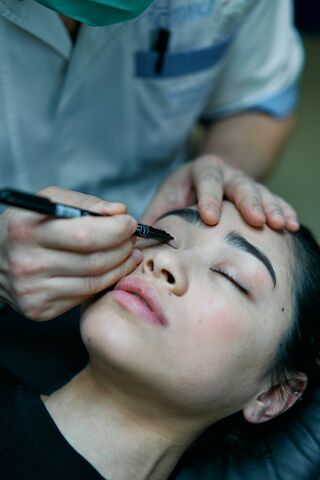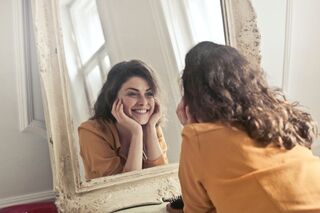Body Image
Who Is Most Likely to Hate Their Face?
New research shows how gender, race, and age shape our feelings about our faces.
Posted March 23, 2022 Reviewed by Gary Drevitch
Key points
- Face satisfaction and body satisfaction are independent of each other, and dissatisfaction with one or the other drives distinct behaviors.
- A new survey finds significant differences in face dissatisfaction between demographic groups.
- Women reported less facial satisfaction overall than men, but both men and women were generally satisfied with their eyes.
- There were pronounced differences in face satisfaction between Black, White, and Asian respondents.

Because faces are so anatomically complex, there are seemingly endless ways we might be dissatisfied with how our own face looks. Nose too small? Forehead too big? Acne? Freckles? One eye slightly bigger than the other? Most research on body image is firmly focused below the neck, examining how feelings about body shape and size affect our mental health. But newly published research on the results of a large survey of U.S. adults attempts to fill a gap in this literature by revealing which demographic groups are more (or less) likely to like their face.
There are several reasons to take face satisfaction more seriously. We are highly sensitive to the appearance of our own faces and the appearance of other people’s faces. Our faces signal our emotional state to others and help us determine how others are feeling. Our ratings of other people’s attractiveness are highly influenced by facial features, and facial features are our main method of telling each other apart. When it comes to how body image can affect behavior, research tends to focus on weight loss attempts and eating disordered behaviors. But facial dissatisfaction drives its own set of behaviors, from the purchase and use of make-up and anti-aging creams, to plastic surgeries and other cosmetic procedures like Botox and fillers.
This new study of face satisfaction was conducted by researchers from multiple universities, as part of a large study called “The U.S. Body Project I.” Identified as the largest national survey on body image yet conducted, researchers surveyed over 10,000 U.S. residents between the ages of 18 and 65. Along with other body image measures, the survey included a face image satisfaction measure that asked respondents to rate how happy they were with their overall face, their eyes, their nose, and the shape of their face.
One of the most striking differences in face satisfaction was between men and women. Women were less satisfied with their faces overall, and with their nose and the shape of their face specifically. Overall, people were most satisfied with their eyes – over 80% of both men and women were happy with how their eyes looked.
Sexual minority men (in this sample, that group was defined as men who identified as either bisexual or gay) were less likely than heterosexual men to be satisfied with their facial appearance. For example, nearly a quarter of gay men reported low overall happiness with their face, compared to 14% of heterosexual men.

The researchers also discovered several notable differences in face satisfaction between racial groups. For example, Asian men and women tended to report lower face satisfaction, particularly with respect to the appearance of their eyes. Only 66% of Asian women were happy with the appearance of their eyes, compared to between 81% to 86% in other racial groups. This finding is consistent with the increasing popularity of “double-eyelid surgery” in some parts of Asia.
Black participants were the most likely to be satisfied with their facial appearance, especially when compared to White men and women. This finding is consistent with other research suggesting that Black women may have higher body satisfaction than other racial groups. Hispanic and White participants tended to land in between Asian and Black participants when it came to face satisfaction.
Survey respondents who reported being in a romantic relationship were more likely to be satisfied with their facial appearance than those who were not. This finding may be related to appearance-pressures associated with dating, especially with online dating apps being populated with so many (often Photoshopped) images of faces.
Though you might guess that older people would be less satisfied with their facial appearance than younger people, age showed only a weak association with face satisfaction. This might seem inconsistent with the amount of time and money people spend battling signs of aging on the face (particularly wrinkles), but the authors suggest that we tend to compare our faces with the faces of people who are similar in age to us, leading to overall stability in facial satisfaction over time. In other words, if everyone you compare yourself to also has wrinkles, wrinkles don’t feel like a big deal.
Across all groups, feeling dissatisfied with the appearance of your face was associated with greater peer pressure, family pressure, and media pressure around appearance. Those who liked their faces less also engaged in more appearance monitoring, meaning they spend more time and energy thinking about how they look to others. People who were more satisfied with the appearance of their face also reported that their body image had a more positive effect on their quality of life. However, it’s worth noting that all study results were correlational, so it’s impossible to determine the direction of influence for these variables. For example, it’s possible that if you spend a lot of time monitoring your appearance, that makes you more sensitive to minor flaws and thus less likely to be satisfied with the appearance of your face. But it’s also possible that when you don’t like how your face looks, that dissatisfaction prompts you to spend more time monitoring how other people might perceive your face.
Another key finding from this research was that face satisfaction and body satisfaction were relatively independent. In other words, you can like your body but not like your face, or vice versa. This suggests that body image researchers need to think carefully about assessing appearance satisfaction both above and below the neck.
The authors noted that they conducted this survey before the COVID-19 pandemic. For those doing remote working and spending a good amount of time on video calls, constant exposure to the image of one’s face might increase facial dissatisfaction. Indeed, some research suggests this might be happening.

There’s also a positive way to spin the results of this study: Overall, more than half of both men and women surveyed landed on the “happy with my face” side of the scale. Given all the cultural pressures that can undermine how we feel about our appearance, maybe that’s not so bad.




